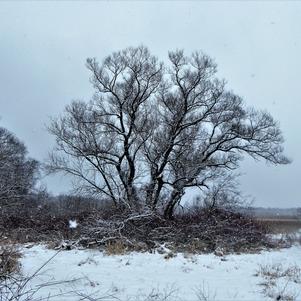General Description
Bloom Description: The blooms consist of a cluster (umbellate raceme) of mauve to occasionally white flowers with five reflexed petals surrounding an elevated central crown. Blooms from late June to early August.
Growth Habit & Shape: At maturity these plants will form tall clumps, and may spread by seed if conditions are favorable.
Soil Preferences: Prefers wet or moist soil conditions, but will survive drought once established in more average-moisture soilis.
Root Description: The roots are fleshy and white, spreading fairly shallowly beneath a short, persistent caudex.
Garden Uses: Swamp milkweed works beautifully in mixed borders and meadow plantings. They can also be seeded or planted in wet roadside ditches and pondside for a stunning visual effect.
Best Management & Maintenance: This is a low-maintenance plant; cut back the previous season's stalks in early spring if desired. If planting in soil that is not consistently moist, water as needed for the first few years to help individuals establish drought-resilience.
Common Problems: When stressed by drought or root-bound in containers, these plants are susceptible to infestation by aphids along the stems, which may kill young, small plants. Remove manually, with neem oil in the early morning or evening, or spray with a dilution of dish soap and water.
Benefits
Ornamental Benefits: This is a plant with a lot of ornamental value, not the least being the butterflies and bees it is certain to attract. Large pink flowers and smooth dark green leaves mix well with other textures, and the beautiful geometry of the vertical standing seed heads provide further visual interest through late fall.
Wildlife Benefits: Like other milkweeds, swamp milkweed attracts large numbers of pollinators, particularly native bees. 12 species of butterfly and moth use this plant as larval host, including the Monarch butterfly.
Other Practical/Environmental Benefits: Takes up space that might otherwise be filled by weeds!
Ecology
Habitat:
In the wild, Asclepias incarnata is found in wet meadows, wetlands, pond edges, ditches, and stream banks.
Response to Disturbance: Though this species prefers consistently moist growing conditions and is severely affected by drought (especially several years in a row), individual plants produce a large quantity of seeds that disperse readily and widely, and that have relatively high germination rates (50-80%). As such, this plant is considered highly resilient to drought and above-ground disturbance. The species is capable of surviving in wet woodlands provided some sunlight, suggesting an ability to survive natural successional changes.
Native State Distributions:
Canada: MB, NB, ON, QC, SKU
USA: AL, AR, CT, DC, DE, FL, GA, IA, IL, IN, KS, KY, MA, MD, ME, MI, MN, MO, MS, NC, ND, NE, NH, NJ, NY, OH, OK, PA, RI, SC, SD, TN, TX, VA, VT, WI, WV
Wetland indicator status: OBL
References
Return to Top
